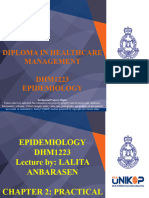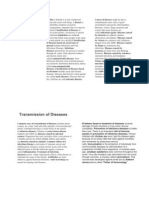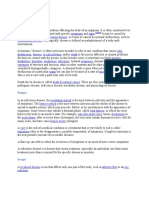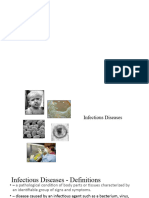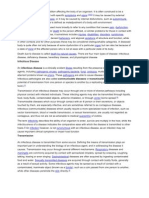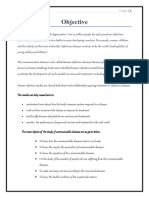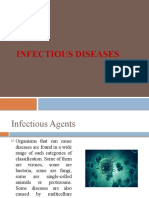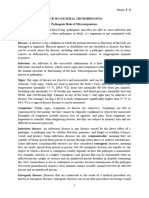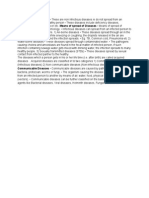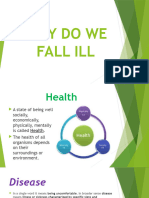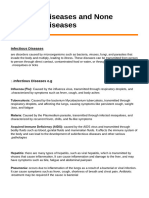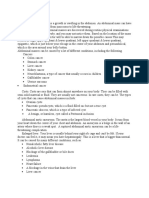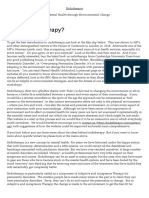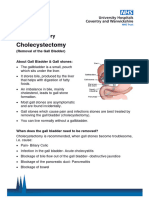Health and Disease
Health and Disease
Uploaded by
KaranGargCopyright:
Available Formats
Health and Disease
Health and Disease
Uploaded by
KaranGargOriginal Title
Copyright
Available Formats
Share this document
Did you find this document useful?
Is this content inappropriate?
Copyright:
Available Formats
Health and Disease
Health and Disease
Uploaded by
KaranGargCopyright:
Available Formats
Health and Disease
Health is a state of complete physical, mental and social well-being of an individual. Health is often affected
by diseases. Disease is the unhealthy condition caused by microorganisms, improper diet or it is
inherited. Disease literally means being uncomfortable. A person affected by the disease will have
improper functioning of the organ systems. Different symptoms which could be established during the
diseased condition include headache, cough, loose motion and wounds with pus.
Classification of diseases
Diseases are categorised based on prevalence, occurrence or spread and duration.
Epidemics are the diseases based on prevalence that attack many people at the same time. E.g. plague.
Infectious diseases are the diseases based on occurrence or spread and duration. These are the
diseases caused by micro-organisms like bacteria, virus, fungi and protozoa. These are spread from one
person to another through air, food, water etc.
Non-infectious diseases are the diseases based on occurrence or spread. These are the diseases
caused by genetic abnormalities. They are called non-communicable diseases as they do not spread from
one person to another. E.g. cancer.
Acute diseases are the diseases based on duration. These diseases last for a short time without posing
adverse effects on the health. E.g. common cold.
Chronic diseases are the diseases based on duration. Chronic diseases last for prolonged period with
drastic effects on health. E.g. Diabetes.
Diseases can also be categorised based on level of causes. These can be immediate or contributory cause.
Immediate cause of the disease can be the microbes causing the disease. E.g. Bacteria.
Contributory causes include causes which contribute to immediate cause. E.g. Genetic difference or poor
nourishment.
Infectious agents
Organisms which cause disease are called as infectious agents. They obtain nourishment from the host.
E.g. Bacteria, Viruses, Fungi, Protozoa, Helminthes.
Bacteria cause diseases like typhoid, cholera, tuberculosis, anthrax, pimples and peptic ulcers.
Viruses cause the common cold, influenza, dengue fever, SARS and AIDS.
Fungi cause skin infections.
Protozoa causes malaria, kala azar and sleeping sickness.
Helminthes worms cause intestinal infections or elephantiasis.
Target organs
these are the different parts of the body attacked by infectious agents. Mode of entry of microbes specifies
the site of localization. Symptoms tell us about the target organ infected.
If the symptoms are cough and breathlessness, then the lungs are the target.
Jaundice is a symptom of the liver, which is a target organ.
If the symptoms are headache, vomiting, fits or unconsciousness, then the brain is the target.
AIDS
AIDS is a viral disease caused by a virus named Human Immuno Deficiency Virus or HIV. HIV attacks the
immune system of an individual and hence he cannot fight back many diseases. HIV finally causes death.
You might also like
- Prisma Health Adult Antimicrobial Guidebook 2021Document52 pagesPrisma Health Adult Antimicrobial Guidebook 2021JhNo ratings yet
- Human Health and DiseaseDocument8 pagesHuman Health and DiseaseRajit krishnaNo ratings yet
- Why Do We Fall Ill Class 9 Notes CBSE Science Chapter 13 PDFDocument4 pagesWhy Do We Fall Ill Class 9 Notes CBSE Science Chapter 13 PDFsakshampriye6No ratings yet
- Chapter 13 - Why Do We Fall Ill: 1. Health and Its FailureDocument3 pagesChapter 13 - Why Do We Fall Ill: 1. Health and Its FailureSahil Gupta100% (1)
- 9 13+resource+23Document7 pages9 13+resource+23geetasatyapriyaNo ratings yet
- Why Do We Fall Ill Class 9Document7 pagesWhy Do We Fall Ill Class 9Madhav Lohchab100% (1)
- Why Do We Fall Ill - Part IiDocument12 pagesWhy Do We Fall Ill - Part IiChhaya GuptaNo ratings yet
- Communicable Diseases Basis For ComparisonDocument8 pagesCommunicable Diseases Basis For ComparisonMohammad ArifNo ratings yet
- Revision - Why Do We Fall Ill NotesDocument15 pagesRevision - Why Do We Fall Ill NotesAtharva VarshneyNo ratings yet
- Why Do We Fall IllDocument6 pagesWhy Do We Fall IllMonika Mehan100% (10)
- Chapter 2Document52 pagesChapter 2Lalita A/P AnbarasenNo ratings yet
- HealthDocument10 pagesHealthAthul ShajiNo ratings yet
- Communicable DiseasesDocument18 pagesCommunicable DiseasesBrandySterlingNo ratings yet
- Health and DiseaseDocument3 pagesHealth and DiseaseMehbub LaskarNo ratings yet
- Document (117)Document4 pagesDocument (117)Joy BhowmickNo ratings yet
- TP 1Document8 pagesTP 1nitesh tirkeyNo ratings yet
- Introduction To Infectious Diseases Lec1 2024Document30 pagesIntroduction To Infectious Diseases Lec1 2024Dictor Omar Botan kheyreNo ratings yet
- Topic: - Disease: Dr. Homi Bhabha Competition Test SeriesDocument10 pagesTopic: - Disease: Dr. Homi Bhabha Competition Test SeriesHarshaWakodkarNo ratings yet
- Basics Definition and ConceptsDocument3 pagesBasics Definition and ConceptsMosama fayyazNo ratings yet
- Why Do We Fall IllDocument10 pagesWhy Do We Fall IllYash KediaNo ratings yet
- Bio Board Project-1Document22 pagesBio Board Project-1Nikita LotlikarNo ratings yet
- DiseaseDocument6 pagesDiseasebioenvironNo ratings yet
- Final Hand in 1Document14 pagesFinal Hand in 1lauraNo ratings yet
- Why Do We Fall IllDocument30 pagesWhy Do We Fall IllbholaNo ratings yet
- Disease and Its Impact On HumansDocument12 pagesDisease and Its Impact On HumansAliana McCarthyNo ratings yet
- Part 2. Causes of DiseasesDocument12 pagesPart 2. Causes of DiseasesKakuru Joseph mNo ratings yet
- Why Do We Fall Ill NotesDocument6 pagesWhy Do We Fall Ill NotessrianshNo ratings yet
- CBSE Class 12 Biology Chapter 8 Human Health and Disease Revision NotesDocument48 pagesCBSE Class 12 Biology Chapter 8 Human Health and Disease Revision Notesdevesh saiNo ratings yet
- Infectious DiseasesDocument11 pagesInfectious DiseasesrexamomosNo ratings yet
- Reasons For Falling IllDocument22 pagesReasons For Falling IllNarayanaNo ratings yet
- Why Do We Fall IllDocument11 pagesWhy Do We Fall IllDilip Kumar KumawatNo ratings yet
- Disease Medical Condition Associated With SpecificDocument11 pagesDisease Medical Condition Associated With SpecificaltzNo ratings yet
- Infectious DiseasesDocument9 pagesInfectious DiseasesSadaf RaniNo ratings yet
- Environment PopulationHealth ProjectDocument4 pagesEnvironment PopulationHealth ProjectAman PoudelNo ratings yet
- Chapter-8-Human Health (SM)Document24 pagesChapter-8-Human Health (SM)zahraababy123No ratings yet
- Chapter OneDocument110 pagesChapter OneAbirham yas.No ratings yet
- Lecture 5 Health and DiseaseDocument38 pagesLecture 5 Health and DiseaseshehzeenaghaNo ratings yet
- Infectious DiseasesDocument5 pagesInfectious DiseaseslmtrumataNo ratings yet
- 13 Why Do We Fall IllDocument25 pages13 Why Do We Fall IllFakhruddin PocketwalaNo ratings yet
- CH13 Ninenth Standard NCERT BOOKDocument26 pagesCH13 Ninenth Standard NCERT BOOKPrash ShanthNo ratings yet
- Diseases-infections-and-immunization-Upper-primary-1Document28 pagesDiseases-infections-and-immunization-Upper-primary-1kimole1990No ratings yet
- Chapter - 13 Why Do We Fall Ill: Notes Class:Ix Biology Page 1 ofDocument8 pagesChapter - 13 Why Do We Fall Ill: Notes Class:Ix Biology Page 1 ofKhatrasNo ratings yet
- Nature of InfectionDocument26 pagesNature of Infectionnayana17042005No ratings yet
- Infectious DiseasesDocument9 pagesInfectious DiseasesSneha DhamijaNo ratings yet
- MCB 201 (Pathogenic Role Og Microbes)Document10 pagesMCB 201 (Pathogenic Role Og Microbes)Obiora Ekene HilaryNo ratings yet
- Communicable Diseases - These Are Non Infectious Diseases Ie Do Not Spread From AnDocument1 pageCommunicable Diseases - These Are Non Infectious Diseases Ie Do Not Spread From AnWillSmithNo ratings yet
- Cause of DiseaseDocument29 pagesCause of DiseaseTariku olanaNo ratings yet
- Environmental EpidemiologyDocument2 pagesEnvironmental EpidemiologyjumcessNo ratings yet
- Infectious Disease and Hormones EmbDocument9 pagesInfectious Disease and Hormones EmbHamze Djibril HassanNo ratings yet
- Eddy MTCDocument61 pagesEddy MTCkhelianderrick81No ratings yet
- Part 2Document43 pagesPart 2asdf asdfNo ratings yet
- Human Health and DiseaseDocument4 pagesHuman Health and DiseaseDev AroraNo ratings yet
- Why Do We Fall IllDocument15 pagesWhy Do We Fall IllFareedha ZaibaaNo ratings yet
- Communicable DiseasesDocument10 pagesCommunicable DiseasesHelloPepsNo ratings yet
- BiologyDocument17 pagesBiologyKrish VermaNo ratings yet
- CDC 1 IntroDocument174 pagesCDC 1 Introdemessie diriba100% (1)
- Communicable Diseases: That Spread From One Person To Another or From An Animal To A Person, or From A Surface or A FoodDocument11 pagesCommunicable Diseases: That Spread From One Person To Another or From An Animal To A Person, or From A Surface or A FoodSalome AnchetaNo ratings yet
- بحث الامراض المعديه والغير معديهDocument5 pagesبحث الامراض المعديه والغير معديهweb86598No ratings yet
- Human Health and Diseases by Ahmed OmaarDocument3 pagesHuman Health and Diseases by Ahmed OmaarAhmed OmaarNo ratings yet
- The Big Book of Infectious Disease Trivia: Everything You Ever Wanted to Know about the World's Worst Pandemics, Epidemics and DiseasesFrom EverandThe Big Book of Infectious Disease Trivia: Everything You Ever Wanted to Know about the World's Worst Pandemics, Epidemics and DiseasesNo ratings yet
- Contagious Diseases: The Science, History, and Future of Epidemics. From Ancient Plagues to Modern Pandemics, How to Stay Ahead of a Global Health CrisisFrom EverandContagious Diseases: The Science, History, and Future of Epidemics. From Ancient Plagues to Modern Pandemics, How to Stay Ahead of a Global Health CrisisNo ratings yet
- 001 - 976 - Ratih Purnamasari Nukana - GalleyDocument6 pages001 - 976 - Ratih Purnamasari Nukana - GalleyWenasNo ratings yet
- PBSDocument72 pagesPBSKavi KaviNo ratings yet
- General Surgery: Post-Operative Care and ManagementDocument9 pagesGeneral Surgery: Post-Operative Care and ManagementMohammed Yousif AbdualjabbarNo ratings yet
- Lisfranc InjuryDocument22 pagesLisfranc InjuryNatasha Janice Minaya CarbonellNo ratings yet
- UntitledDocument73 pagesUntitledMark Julius ElepanioNo ratings yet
- Ncmb316 - Medical Surgical Nursing: Bachelor of Science in NursingDocument12 pagesNcmb316 - Medical Surgical Nursing: Bachelor of Science in NursingMichelle Gliselle Guinto MallareNo ratings yet
- Nidotherapy - Better Mental Health Through Environmental ChangeDocument6 pagesNidotherapy - Better Mental Health Through Environmental ChangeGunreddy RajareddyNo ratings yet
- Obstetrical ShockDocument56 pagesObstetrical ShockDrPreeti Thakur ChouhanNo ratings yet
- Laporan Kanker April 2023 Update Akhir AprilDocument44 pagesLaporan Kanker April 2023 Update Akhir AprilaulianiesaNo ratings yet
- FHC ChittarikkalDocument1 pageFHC Chittarikkalkevin princeNo ratings yet
- Nursing Care Plan. HypertensionDocument2 pagesNursing Care Plan. HypertensionKiara Shanelle Posadas AbrioNo ratings yet
- Antimicrobial StewardshipDocument31 pagesAntimicrobial StewardshipPrathusha Umakhanth100% (2)
- Assessmen T Nursing Diagnosi S Nursing Goal Nursing Intervention Rationale Subjective Cues: Independent IndependentDocument3 pagesAssessmen T Nursing Diagnosi S Nursing Goal Nursing Intervention Rationale Subjective Cues: Independent IndependentKim Glaidyl BontuyanNo ratings yet
- Abnormal Uterine Bleeding (AUB)Document45 pagesAbnormal Uterine Bleeding (AUB)asdf0% (1)
- TRABAJO DE TIEMPOS VERBALES (Actividad Nro. 01)Document7 pagesTRABAJO DE TIEMPOS VERBALES (Actividad Nro. 01)Utisca, CA. Servicio Tecnico de Archivos RodantesNo ratings yet
- ParkinsonDocument24 pagesParkinsonSandy AgustianNo ratings yet
- Chapter 9Document11 pagesChapter 9hanniaitiel69No ratings yet
- Cholecystectomy (Removal of The Gall Bladder)Document6 pagesCholecystectomy (Removal of The Gall Bladder)Akash ShillNo ratings yet
- Autism Spectrum Disorder EssayDocument6 pagesAutism Spectrum Disorder Essayfaithjackk04No ratings yet
- Face Masks Are Not Effective?Document5 pagesFace Masks Are Not Effective?Adam FernandezNo ratings yet
- Rectal Examination OSCE GuideDocument8 pagesRectal Examination OSCE Guidecharlyn206No ratings yet
- Cardiology GuideDocument299 pagesCardiology Guidetnandanwar91100% (1)
- Mantoux TestDocument10 pagesMantoux TestAnonymous czrvb3h0% (1)
- Full Download Gastrointestinal and Liver Pathology: A Volume in The Series: Foundations in Diagnostic Pathology 3rd Edition Amitabh Srivastava PDFDocument49 pagesFull Download Gastrointestinal and Liver Pathology: A Volume in The Series: Foundations in Diagnostic Pathology 3rd Edition Amitabh Srivastava PDFlidjachules100% (6)
- 1 s2.0 S2667147621000510 MainDocument7 pages1 s2.0 S2667147621000510 MainDiahNo ratings yet
- Rash Non Blanching Nhs GuidesDocument3 pagesRash Non Blanching Nhs Guidesapi-238551404No ratings yet
- Lembar Kerja Siswa Xi TKRDocument13 pagesLembar Kerja Siswa Xi TKRRian HernandiNo ratings yet
- 50 Topics List 1Document1 page50 Topics List 1akanksha singhNo ratings yet
- Health Assessment Lower Back PainDocument3 pagesHealth Assessment Lower Back PainArnold TemporosaNo ratings yet










